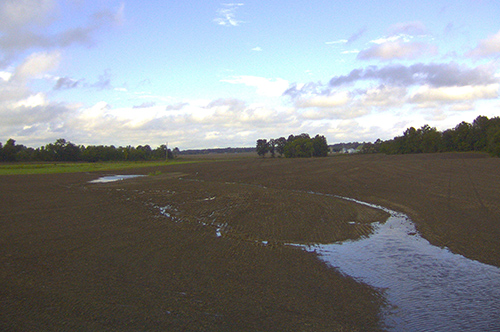WKU News
2018 one of wettest years on record in Kentucky
- WKU News
- Monday, January 14th, 2019

The camera at the Kentucky Mesonet at WKU station in Henderson County captured this image after rainfall on Sept. 25, 2018.
The final results are in: 2018 was one of the wettest years on record in Kentucky and throughout much of the Midwest.
Stations comprising the Kentucky Mesonet at WKU, the state’s official source of climatological observations, reported a statewide average of 63.08 inches of precipitation for the year. According to data available through the Midwestern Regional Climate Center, the record wettest year in Kentucky dating back to 1895 is 2011 with a statewide average of 64.35 inches.
State climatologist Stuart Foster, director of the Kentucky Climate Center and the Kentucky Mesonet at WKU, noted that precipitation was well distributed throughout the year. “The wettest months were February and September, but no month averaged more than 10 inches,” he said. “As a result, there was only minor river flooding reported in 2018. In contrast, the record setting year of 2011 included as much as 20 inches of rain in some areas during April and early May, resulting in extensive flooding along the lower reaches of the Ohio River and its tributaries.”
Dr. Foster provided the following details about 2018 precipitation:
- 87.59 inches on Black Mountain: The highest annual precipitation total recorded at any site across Kentucky for 2018 was at the Mesonet station on Black Mountain in Harlan County with 87.59 inches, just shy of the all-time record of 88.07 inches at Caneyville in 1979.
- Record year in Lexington: Records were set at many long-term stations maintained by the National Weather Service, including the station at Lexington’s Bluegrass Airport, which recorded 71.98 inches, the highest annual total in records that go back as far as 1872.
- September rain eased drought worries: Concerns about encroaching drought in the Jackson Purchase counties of western Kentucky during August 2018 were eased by the rains in September before conditions became serious. Wet conditions through the fall posed challenges for farmers to harvest crops.
- State wetter than average since 2010: The wet conditions of 2018 are nothing new across Kentucky. While the western portions of the state suffered from extreme drought in the spring and summer of 2012 and a dry fall contributed to widespread wildfires in 2016, Kentucky has experienced a prolonged period of unusually wet conditions. The 24-month Standardized Precipitation Index, which tracks the rolling two-year statewide precipitation total, shows that Kentucky has remained wetter than average since April 2010, the longest such period on record dating back to 1895.
- Historical variability: Kentucky’s climate is characterized by significant variability. Kentucky has witnessed other periods of unusual wetness in the past, including a recent period during the 1970s. Meanwhile, periodic droughts also impact the state, with the 1930s and the 1950s standing out in the historical record.
- A look to the future: Model projections of Kentucky’s climate through the remainder of the century indicate that the state can expect wetter conditions on average, particularly during the cool season. With increasing summertime temperatures, droughts and heatwaves are expected to become more severe.
About the Kentucky Mesonet at WKU: The Kentucky Mesonet at WKU is the Commonwealth’s official source for weather and climate data. The statewide network includes 70 stations in 69 counties: Adair, Allen, Barren, Bath, Boone, Boyle, Breathitt, Breckinridge, Bullitt, Butler, Caldwell, Calloway, Campbell, Carroll, Casey, Christian, Clark, Clinton, Crittenden, Cumberland, Fayette, Franklin, Fulton, Graves, Grayson, Hardin, Harlan, Harrison, Hart, Henderson, Hopkins, Jackson, Johnson, Knott, Knox, LaRue, Lawrence, Letcher, Lewis, Lincoln, Logan, Madison, Marion, Marshall, Mason, McLean, McCreary, Meade, Mercer, Metcalfe, Monroe, Morgan, Muhlenberg, Nicholas, Ohio, Oldham, Owen, Owsley, Pike, Pulaski, Rowan, Shelby, Simpson, Taylor, Todd, Trigg, Union, Warren and Webster. The Mesonet stations collect real-time data on temperature, precipitation, humidity, solar radiation, wind speed and direction and transmit it to the Kentucky Climate Center at WKU every five minutes, 24 hours per day, throughout the year. The data is available online at www.kymesonet.org.
Contact: Stuart Foster, (270) 745-5983

